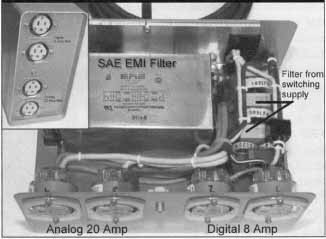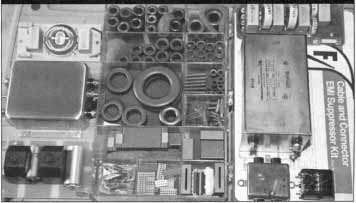AMAZON multi-meters discounts AMAZON oscilloscope discounts
Build this quality AC line (EMI and RF) filter for less than $100 with surplus parts and recycled filters from old server switching power supplies. It will improve the performance of many data acquisition, signal-conditioning and digital systems and is easy to put together.
Now that you have finished that new data-acquisition (DAQ) or critical-systems computer/digital project, done all that hard work, and spent way too much, you fire it up only to be disappointed because the performance or reliability is not what you had hoped. Or, after upgrading everything, your system just doesn’t perform at the level expected. Well, you may be the victim of AC pollution, and not realize that it can degrade digital-electronics performance and reliability.
Our power grid is a huge electromagnetic network spewing out noise and interference across the spectrum. A good filter can control and reduce this interference, improving the performance and reliability of your entire system. Of course, isolation transformers, line conditioners, and regulators are the best solutions for EMI problems and waveform regeneration, but at higher currents (15+A) they can be quite expensive. So if you need a way to clean up your AC, try this approach.
We constructed this mains (AC line) filter (fig. 1) using an
SAE two-stage EMI filter (bought from www.ebay.com ) and a line filter (fig 2)
pulled from a discarded server switching power supply. It has two analog
outputs rated at 20 Amp (for monitors, scanners, printers) and two digital
outputs at 8 Amp (for computers and DAQ systems). A large ferrite core
(#43) was looped through twice at the AC entry point, and came from the
sample kit (fig. 2), also purchased from a local surplus or electronics
shop.

Above: Fig. 1. Top view and front (inset) of completed project.

Above: Fig. 2. Ferrite cores and filters for EMI are often available
as "EMI Suppresor Kits"
If you have trouble finding these items surplus,eBay , Mouser, and Digi-Key carry most of them. If you choose to build one, the circuit
is simply a multistage pi filter (see schematic), and you can find others
on the net, but it’s easier to buy them already potted in a metal case
(fig 2).

Above: Schematc of EMI filter
A computer recycler or eBay is a good place to start, as many servers use high-current switch-mode power supplies and rely on filters to keep switching noise from being imparted back to the AC line. That also makes them perfect for isolating your analog from your digital power; otherwise, you just re-contaminate your nice clean AC when you plug in your PC, signal-conditioning board or DAQ board. When installing these filters, make sure the metal case is in good electrical contact with the enclosure. A large ground strap from the filter’s GND post to a location where the paint has been removed should ensure this.
NOISE SUPPRESSION GUIDELINES
Low frequency fields can be difficult to control particularly if they are from the AC power transformer. Stray magnetic fields (low frequency) from transformers can cause hum and other annoying noise. Short of a 1” thick lead shield, there are some other effective ways to quell these fields:
- place the transformers in a separate metal enclosure
- use silicon steel shields or shading rings around the transformer
- run cables as close to enclosure sides as possible and place sensitive circuitry away from power transformers
High frequency fields can enter a metal enclosure through openings as small as 20mm. This means that all connectors should be metal and holes larger than 20mm be covered in mesh. External cables should be shielded and internal shielded cables need to be grounded on one end. Enclosure panel thickness should be at least 2mm or more and heat sinks should be grounded if possible at several points. Use ferrite beads and cores for cables carrying 10kHz or higher (except analog audio signal lines). Clean AC can't be taken for granted and requires some effort to attain. It has been shown that noise introduced into the power supply can find its way into, and adversely affect, audio signals and ultimately system performance.
Related article: The
Basics of Electrical Grounding and Ground
Loops